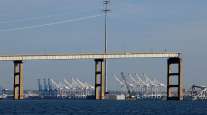Senior Reporter
Secretaries Buttigieg, Granholm Tout EVs at TRB

[Stay on top of transportation news: Get TTNews in your inbox.]
WASHINGTON — Recent policies linked to electric vehicles are helping to address climate change and improve safety across mobility corridors, the nation’s top transportation officer told stakeholders on Jan. 11.
“The industry is going electric,” Secretary Pete Buttigieg said at the annual meeting of the Transportation Research Board. “It’s true here and it’s true around the world.”
“There’s enormous opportunity,” added Buttigieg, pointing to large automobile manufacturers and smaller firms participating in the EV marketplace.
Energy Secretary Jennifer Granholm echoed Buttigieg’s sentiment at the conference, emphasizing the Biden administration’s policy landscape on EVs.
At the #TRBAM fireside chat, @SecretaryPete started by announcing that the @faa situation from this morning has been resolved. pic.twitter.com/bbkHEVBtNq — TRB (@NASEMTRB) January 11, 2023
“Policy really does make a difference,” she told the TRB audience. “It makes a difference for the climate. It makes a difference for communities on the ground. We’re very excited about that.”
Biden administration investments in electric vehicle charging infrastructure that were approved in a $1.2 trillion infrastructure law promise to continue to facilitate access to the technology, the secretaries said.
Their remarks came on the heels of the Biden administration’s announcement of a multi-agency blueprint meant to reduce greenhouse emissions throughout the transportation sector over the coming decades. The expansion of electric vehicles and programs related to sustainable fuels is expected to assist the sector in addressing climate change concerns and expanding job growth.
“A well-planned transition to a decarbonized transportation system can address these and other inequities and provide equitable, affordable and accessible options for moving people and goods,” according to the U.S. National Blueprint for Transportation Decarbonization unveiled Jan. 10. Agencies involved in the blueprint include DOT, the departments of Energy, and Housing and Urban Development, and the Environmental Protection Agency.
“Further developing and deploying clean-energy technologies such as electric vehicles and hydrogen and sustainable fuels, while also building out the supporting infrastructure for clean transportation, will create good-paying jobs across all segments of the transportation sector and strengthen America’s energy independence,” according to background about the blueprint from DOT.
“Under the leadership of President [Joe] Biden, EPA is working with our federal partners to aggressively reduce pollution that is harming people and our planet — while saving families money at the same time,” EPA Administrator Michael Regan said in a statement accompanying the release of the blueprint. “At EPA, our priority is to protect public health, especially in overburdened communities, while advancing the president’s ambitious climate agenda. This blueprint is a step forward in delivering on those goals and accelerating the transition to a clean transportation future.”

Regan
Relatedly, the 2021 Infrastructure Investment and Jobs Act paved the way for the Joint Office of Energy and Transportation. The office’s aim is to help set up an electric vehicle charging network nationwide. The infrastructure law dedicated about $8 billion for programs related to electric vehicles.
According to background the Biden administration provided, “The office will be a critical component in the implementation of the [bipartisan infrastructure law], providing support and expertise to a multitude of programs that seek to deploy a network of electric vehicle chargers, zero-emission fueling infrastructure, and zero-emission transit and school buses. The scope of the joint office will continue to evolve as directed by both departments.”
Electric vehicles also were a highlight of DOT’s research and development outlook through fiscal 2026. The strategic road map for transportation technology promotes innovative advancements in EVs.
To promote sustainability, DOT forecasts, “the vast majority of passenger vehicles and buses are hybrid or fully electric and the efficiency of internal combustion engines is greatly improved.”
“Advances in battery and charging technology make long-range, fast-charging, safe and affordable electric vehicles the default options for consumers, motor carriers and transit agencies,” according to the strategic plan.
Through the enactment of an expansive climate change measure last year, the U.S. Postal Service announced a $9.6 billion investment for 66,000 electric delivery trucks. The postal service has the largest vehicle fleet within the federal apparatus.
Want more news? Listen to today's daily briefing below or go here for more info:




